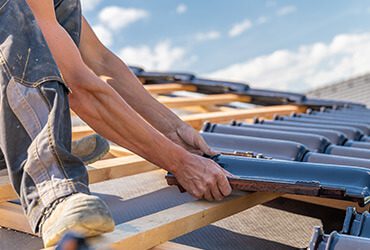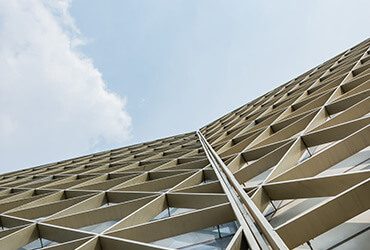All important info
on Flat roofing
Flat roofing systems are a type of roofing system that is used on commercial buildings and some residential properties. They are characterized by a flat or nearly flat surface, as opposed to the pitched or sloping surface of traditional roofs. Flat roofs are typically made from a variety of materials, including asphalt, rubber, and PVC, and require regular maintenance to ensure their longevity.
One of the main advantages of flat roofing systems is their simplicity and cost-effectiveness. They are typically easier and cheaper to install than pitched roofs, and may be a good choice for buildings with large, open spaces or those that are difficult to access. Flat roofs are also relatively easy to maintain and repair, as they have a relatively simple structure with few angles or slopes.
It’s also worth noting that flat roofing systems come in a variety of materials, each with its own set of benefits and drawbacks.
Despite their many benefits, flat roofs do have some limitations. They are not as good at shedding water as pitched roofs, and can be more prone to leaks and water damage if not properly maintained. Flat roofs are also more vulnerable to damage from extreme weather conditions, such as high winds and heavy rain.
To ensure the longevity and performance of a flat roof, it is important to choose a high-quality roofing material and to follow proper installation and maintenance practices. This may include regular inspections, repairs, and cleaning, as well as using protective coatings or membranes to seal and protect the roof.


Overall, flat roofing systems can be a practical and cost-effective choice for commercial and residential buildings, provided that they are properly designed, installed, and maintained. By working with a reputable roofing company, you can ensure that your flat roof meets your needs and lasts for many years to come.
It’s important to consider the specific needs and budget of your project when choosing a flat roofing material. A reputable roofing company can help you determine the best material for your needs and provide expert installation and maintenance services.
10 Efficient & Measurable Benefits of Software..
Lorem ipsum dolor sit amet consec tetur adipisicing sed do eiusmod tempor incid idunt labore dolore magna aliqua enim ad minim veniam. quis nostrud exercitation ullamco laboris nisi ut aliquip ex ea commodo consequat duis aute irure dolor in reprehenderit in voluptate velit esse cillum dolore eu fugiat nulla pariatur.
Excepteur sint occaecat cupidatat non proident, sunt in culpa qui officia deserunt mollit anim id est laborum. Sed ut perspiciatis unde omnis iste natus error sit voluptatem accusantium doloremque laudantium totam rem aperiam eaque ipsa quae.
Enim ad minim veniam, quis nostrud exercitation ullamco laboris nisi ut aliquip ex ea commodo consequat duis aute irure dolor in reprehen derit in esse.
Lorem ipsum dolor sit amet consec tetur adipisicing sed do eiusmod tempor incid idunt labore dolore magna aliqua enim ad minim veniam. quis nostrud exercitation ullamco laboris nisi ut aliquip ex ea commodo consequat duis aute irure dolor in reprehenderit in voluptate velit esse cillum dolore eu fugiat nulla pariatur.
Excepteur sint occaecat cupidatat non proident, sunt in culpa qui officia deserunt mollit anim id est laborum. Sed ut perspiciatis unde omnis iste natus error sit voluptatem accusantium doloremque laudantium totam rem aperiam eaque ipsa quae.


Adipisicing sed do eiusmod tempor incid idunt labore dolore magna aliqua enim ad minim veniam. quis nostrud exercitation ullamco laboris nisi ut aliquip ex ea commodo consequat duis aute irure dolor in reprehenderit.
Roof underlayment and flashing
Roof underlayment and flashing are two important components of a roofing system that play a crucial role in protecting a building from water damage. In this post, we will delve into the details of roof underlayment and flashing, explaining what they are, how they work, and why they are important.
Roof underlayment is a layer of material that is installed under the roofing material to provide an extra layer of protection for the roof. It is often made of a synthetic material such as felt paper, rubberized asphalt, or a synthetic polymer. Roof underlayment is installed on top of the roof deck and under the roofing material, and serves as a secondary water barrier in case the primary roofing material fails.
Roof flashing is an important component of a roofing system because it helps to prevent leaks and water damage to the roof and the building.
Roof flashing is a thin material, usually made of metal, that is used to seal the joints and seams on a roof. It is typically installed around areas of the roof that are prone to leaks, such as chimneys, skylights, and vents. Roof flashing is designed to prevent water from seeping through these joints and into the building.
Roof underlayment works by providing a layer of protection between the roof deck and the roofing material. It acts as a barrier to prevent water from seeping through the roof and into the building. When installed properly, roof underlayment can help to prevent leaks and water damage to the roof and the building.


Roof flashing works by sealing the joints and seams on a roof, preventing water from seeping through these areas and into the building. It is typically installed around areas of the roof that are prone to leaks, such as chimneys, skylights, and vents. When installed correctly, roof flashing helps to prevent leaks and water damage to the roof and the building.
Roof underlayment is an important component of a roofing system for several reasons. First and foremost, it provides an extra layer of protection against water damage. If the primary roofing material fails, the roof underlayment can help to prevent leaks and water damage to the roof and the building. In addition, roof underlayment helps to prevent moisture from accumulating on the roof deck, which can lead to rot and other types of damage.


